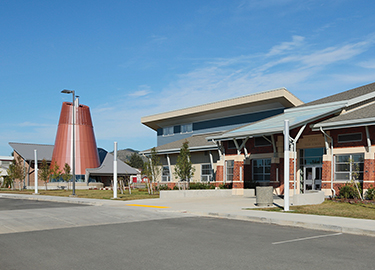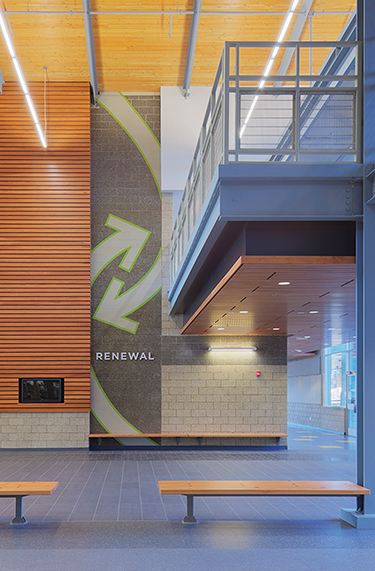|
Subscribe / Renew |
|
|
Contact Us |
|
| ► Subscribe to our Free Weekly Newsletter | |
| home | Welcome, sign in or click here to subscribe. | login |
Construction
| |
 |
August 30, 2018
Schools have more ways than ever to go green
BLRB Architects

Fenton
|
When we hear the word “sustainability” our thoughts turn to renewable energy, reducing carbon emissions and being mindful of the balance of our planet’s ecosystems.
Sustainable architectural design (aka green design) seeks to minimize the effect of built structures on human health, natural resources and the environment.
Improved health and productivity of students and staff, resource conservation and even energy generation are commonly achieved benefits of green school design. Accompanying benefits — reduced maintenance costs, operational cost-efficiency and extended facility longevity — can be a boon to school districts that are balancing perennially shrinking capital budgets against growing capital improvement needs.
The mandate to design energy-efficient, environmentally conscious schools has been steadily moving from an option to an imperative.
Washington state-funded school construction projects greater than 5,000 square feet are required to incorporate sustainable features outlined in the Washington Sustainable Schools Protocol (WSSP) criteria, a self-certifying standard for the development of high-performance schools. School districts may also choose to pursue LEED certification if their sustainability goals are more aggressive.
Active green strategies
Broadly speaking, sustainable design in educational architecture is a matter of degree. Active sustainable design strategies are deliberate choices that may represent a deviation from what might most often be integrated into designs for comparable schools.
These elements, like those that follow, are typically specialized systems or structures that actually generate energy or dramatically reduce energy consumption. Photovoltaic panels are being used more widely in K-12 facilities as the technology becomes increasingly accessible, and end-of-use recycling technologies are evolving to minimize the environmental impact of processing used components.
While upfront purchase and installation costs are still a consideration, life-cycle operating costs are exceptionally lower than traditional power technologies. Continued advances in power output, solar collection and energy-storage capacity are making this one of the fastest-growing sources of clean, renewable energy for schools and other facility types across the country.
Though not as commonly employed in school design as photovoltaics, biomass energy production has several environmental advantages.
Wood is a renewable resource and typically costs less than fossil fuels. Wood combustion systems for electricity and heat utilize wood residues and byproducts, yielding reduced environmental impact from industry waste products. Biomass carbon dioxide emissions are approximately 90 percent less than burning fossil fuel.
A ground-source heat exchange system uses the earth as a heat source in winter and a heat sink in summer.
The system design relies on consistently moderate ground temperatures to boost mechanical efficiency and reduce the operating costs of heating and cooling systems. When coupled with solar heating technology, this becomes a geosolar system, which is even more efficient than either technology employed alone.
Green roofs are both beautiful and a sustainable strategy with positive impacts on multiple fronts. The insulating nature of the planting media and vegetation reduce energy consumption, and, subsequently, heating and cooling costs.
Green roofs can actually extend the life of a roof by narrowing the variance in temperature changes that result in expansion, contraction, and the resulting wear and tear on roofing materials. The resulting mini-ecosystems green roofs provide offer habitat for birds, bees and insects, especially valuable in urban environments with reduced green space. They also provide a unique and engaging teaching tool for science curricula.
Passive green strategies
In contrast with active strategies, passive sustainable elements employ what already exists — sunlight, shade, wind, temperature differences, gravity, etc. — to achieve sustainable impacts without an additional expenditure of resources. These elements are valued for their simplicity, ease of integration, aesthetic contribution to building design, and low or no operational costs.
Rather than adding time and expense trying to wrestle a site into submission, simply tailoring the design and orientation of a school to suit its unique site characteristics yields sustainable benefits.
Preserving existing site characteristics including old-growth trees, vegetation and natural topography helps facilitate a connection between students and the environment, provide outdoor learning spaces, conserve energy via shade-producing plantings, and help manage stormwater run-off.
Interior glazing, expansive exterior windows, integrated skylights and light wells all work to infuse natural light throughout school interiors, reducing lighting costs, enhancing indoor environmental quality and contributing to an energizing interior. Sunshades and building overhangs thoughtfully addressed in building envelope design will mitigate glare and heat build-up.
Likewise, operable windows in classrooms naturally improve indoor-air quality via passive ventilation and also reduce energy use for facility cooling on warm days.
And finally, interior and exterior material choices are key to enhancing sustainability. Integrating sustainably sourced, renewable and repurposed building materials, along with low- or no-VOC interior finishes and flooring, safeguards the environment and contributes to healthy indoor learning environments.
How do we measure the effectiveness of sustainability initiatives in the school environment? While practical issues like life-cycle operating costs, cost-effective maintenance and facility durability are important, healthy schools, healthy kids and a healthy planet are at the heart of the green conversation.
Regardless of the design standard pursued or the sustainable strategies employed in school design, it all counts.
Lee Fenton is a principal at BLRB Architects whose 30-plus years of architectural planning and design has focused on the development of K-12 school facilities.
Other Stories:
- It's much easier for schools to get to net zero
- How enviro consultants can lend your school project a helping hand
- UW Life Sciences Building: giant firs and bird songs offer a one-of-a-kind elevator ride
- 3 keys to building green schools: design, operations and renewables
- Bremerton alternative school breaks down walls to learning
- Studies suggest design really can affect how well students learn
- The view from inside a school: what really makes it safe
- Eastside Prep’s versatile arts hall made for concerts, plays and yoga
- After two decades, UW’s SLU campus nears completion
- How playgrounds make all children feel welcome
- See-through schools spark interest in learning
- OSU football center opts for flexible lighting scheme
- Stretch your tight budget by getting creative
- Long-distance teams worked in concert to remake Wyoming school theater




